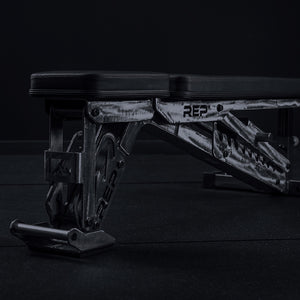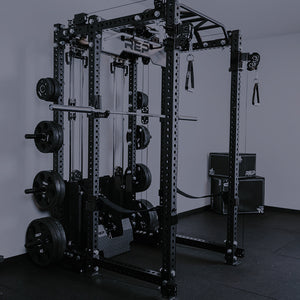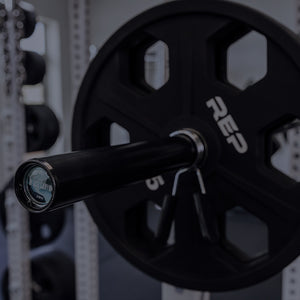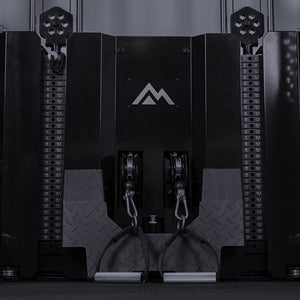Tayler Sykes loves her affiliate gym, CrossFit 970, in Northern Colorado. She also loves her home gym, a short drive away.
Sometimes two gyms are better than one.
Sykes, a pro CrossFitter and coach, began really building out her home gym in 2020 during the lockdowns. Then, last year, her home gym needs escalated after she qualified for the semifinals. To train, she needed to double up her workouts: mornings at 970 and the rest of her work at home – the more time-consuming stuff, like rowing and squats. Beyond the flexibility and convenience, she says a home gym keeps her from feeling rushed in the squat rack, and it mixes up those long training days.
Whether you’re leveling up, like Sykes, or just looking to BYOB (build your own box), here’s what she recommends for a basic, at-home CrossFit gym – in order of priority.
1. A Rower

The first piece of equipment Sykes bought for her home gym was a rowing machine.
“A lot of long sessions were the cardio pieces on the rower, and it made sense to do that at home,” she says.
For cardio, rowing is her favorite because it works your full body. It also has no impact on your joints.
One rowing option is the Concept2 Row Erg, with a fanned flywheel that uses air resistance to respond to your effort with every stroke. It comes equipped with a top-of-the-line PM5 Monitor, which can connect with various apps and a wireless heart-rate monitor. The monitor allows you to pick between various workouts and track pace, watts, stroke rate, and calories. All the deets you need to maximize your training.
2. A barbell and weights
The first piece of strength equipment that Sykes recommends is a mixed-use barbell – one you can use for both Olympic-style lifts, as well as squats, bench presses, and deadlifts.
A great multi-purpose bar is the Excalibur, with both bearing and bushing sleeves and medium/deep knurling. The bushing design provides stability for powerlifting-style lifts, while the bearing allows plenty of spin for Olympic-style lifts.
Of course, a barbell is only as useful as the weight you can put on it, so Sykes also recommends picking up a solid weight plate set, too. With CrossFit, bumper plates are a fave over irons, in case you need to drop the bar and don’t want to damage the floors and equipment.

Tayler Sykes lifting weights. Photo by Whitney Way Collective
3. A power rack

A power rack goes hand in hand with a barbell, making squats and presses much easier (and safer). Sykes recommends a quality rack that you can build on over the years – one that’s compatible with many attachments, in case you want to add more options to your home gym.
“A lot of people come to their regular CrossFit class, and sometimes an hour is not long enough to cram all the things in, so strength pieces can unfortunately get neglected in a gym,” Sykes says. "So, that’s something I recommend all members do at home: Follow a good strength program.”
Build your own power rack and see how it’ll look in your own space with REP’s Rack Builder. One versatile power rack great for CrossFit is the PR-4000. Sykes recommends adding a Multi-Grip Pull-Up Bar to your power rack so you can train various options for pull-ups.
4. Kettlebells
When deciding between a set of dumbbells or kettlebells, Sykes prefers the latter.
“For the most part, everything you can do with a dumbbell you can do with a kettlebell, but not the other way around,” she says.
CrossFit covers a ton of kettlebell exercises, she says: kettlebell snatches, swings, and deadlifts. Plus, kettlebells are great for accessory work because they demand a lot of stabilizing muscles.
“This is what I’ve learned the most this past year – over anything,” Sykes says.
She recommends starting with a pair of 35s or a pair of 55s, the typical CrossFit competition weight for women and men, respectively. Of course, the weight you choose ultimately depends on your experience and strength level, as well as how you want to use them.

5. A Medicine Ball

Wall ball throws are a common CrossFit exercise, and Medicine Balls are perfect for it.
Pick up a Wall Ball Target, if you want to practice with precision; mount it to your Rig, PR-4000, PR-5000, or wall at the standard height (10’ for men and 9’ for women).
Sykes recommends a 14lb ball for women and a 20lb ball for men, which has traditionally been the CrossFit weight standard.
6. An Ab Support Mat
A strong core sets the groundwork for all CrossFit exercises, Sykes says; a tree trunk midsection protects your back. If you hurt your back, it knocks out everything else.
That’s why Sykes also recommends adding an Ab Support Mat to your home gym.
This mat allows your spine and hips to pivot optimally to engage your core muscles properly. Its shape follows the contours of your back.
You can also use an ab mat to comfort your knees during lunges and other floor exercises.

7. A jump rope
Another cardiovascular tool that’s inexpensive and takes up no real space is a jump rope. Sykes likes to pair it with another exercise, like wall ball throws.
“Double-unders are big in the CrossFit space, so this is a solid go-to,” Sykes says.
The Speed Competition Rope is ideal for double-unders and more advanced jump roping. The handle features ball bearing mechanisms that create swivel points for quick and smooth movements.

Tayler Sykes jumping rope. Photo by Whitney Way Collective
Other add-ons for your at-home Crossfit gym

Pull-up Bands for warm-ups and accessories

Horizontal Plate Rack to organize your bumpers

Floor Mats to protect your floors and equipment





